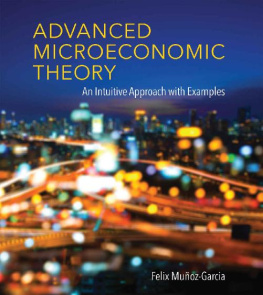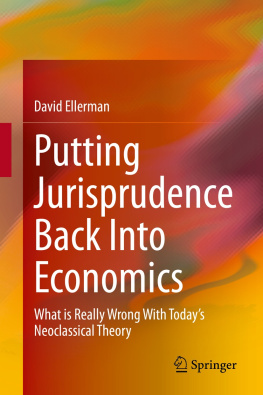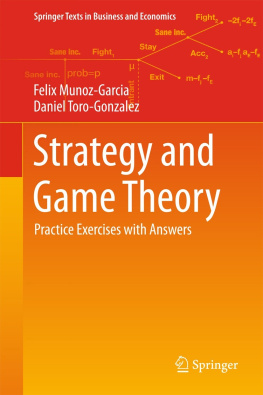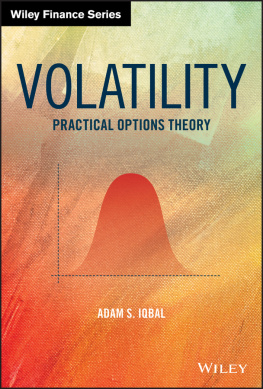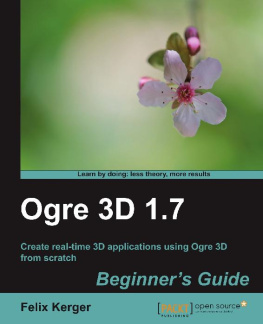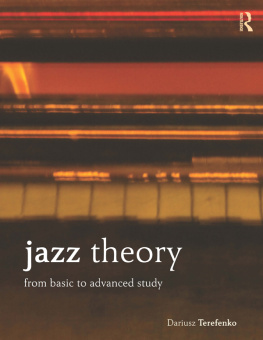Felix Munoz-Garcia - Advanced Microeconomic Theory: An Intuitive Approach with Examples
Here you can read online Felix Munoz-Garcia - Advanced Microeconomic Theory: An Intuitive Approach with Examples full text of the book (entire story) in english for free. Download pdf and epub, get meaning, cover and reviews about this ebook. year: 2017, publisher: MIT Press, genre: Children. Description of the work, (preface) as well as reviews are available. Best literature library LitArk.com created for fans of good reading and offers a wide selection of genres:
Romance novel
Science fiction
Adventure
Detective
Science
History
Home and family
Prose
Art
Politics
Computer
Non-fiction
Religion
Business
Children
Humor
Choose a favorite category and find really read worthwhile books. Enjoy immersion in the world of imagination, feel the emotions of the characters or learn something new for yourself, make an fascinating discovery.
- Book:Advanced Microeconomic Theory: An Intuitive Approach with Examples
- Author:
- Publisher:MIT Press
- Genre:
- Year:2017
- Rating:5 / 5
- Favourites:Add to favourites
- Your mark:
- 100
- 1
- 2
- 3
- 4
- 5
Advanced Microeconomic Theory: An Intuitive Approach with Examples: summary, description and annotation
We offer to read an annotation, description, summary or preface (depends on what the author of the book "Advanced Microeconomic Theory: An Intuitive Approach with Examples" wrote himself). If you haven't found the necessary information about the book — write in the comments, we will try to find it.
Advanced Microeconomic Theory: An Intuitive Approach with Examples — read online for free the complete book (whole text) full work
Below is the text of the book, divided by pages. System saving the place of the last page read, allows you to conveniently read the book "Advanced Microeconomic Theory: An Intuitive Approach with Examples" online for free, without having to search again every time where you left off. Put a bookmark, and you can go to the page where you finished reading at any time.
Font size:
Interval:
Bookmark:
 Advanced Microeconomic TheoryAdvanced Microeconomic TheoryAn Intuitive Approach with ExamplesFelix Muoz-GarciaThe MIT PressCambridge, MassachusettsLondon, England 2017 Massachusetts Institute of Technology All rights reserved. No part of this book may be reproduced in any form by any electronic or mechanical means (including photocopying, recording, or information storage and retrieval) without permission in writing from the publisher. This book was set in Times New Roman by Toppan Best-set Premedia Limited. Library of Congress Cataloging-in-Publication Data Names: Muoz-Garcia, Felix, author. Title: Advanced microeconomic theory : an intuitive approach with examples / Felix Muoz-Garcia. | Includes bibliographical references and index. | Includes bibliographical references and index.
Advanced Microeconomic TheoryAdvanced Microeconomic TheoryAn Intuitive Approach with ExamplesFelix Muoz-GarciaThe MIT PressCambridge, MassachusettsLondon, England 2017 Massachusetts Institute of Technology All rights reserved. No part of this book may be reproduced in any form by any electronic or mechanical means (including photocopying, recording, or information storage and retrieval) without permission in writing from the publisher. This book was set in Times New Roman by Toppan Best-set Premedia Limited. Library of Congress Cataloging-in-Publication Data Names: Muoz-Garcia, Felix, author. Title: Advanced microeconomic theory : an intuitive approach with examples / Felix Muoz-Garcia. | Includes bibliographical references and index. | Includes bibliographical references and index.
Identifiers: LCCN 2016023457 | ISBN 9780262035446 (hardcover : alk. paper) Subjects: LCSH: Microeconomics. | Economics, Mathematical. Classification: LCC HB172 .M86 2017 | DDC 338.5--dc23 LC record available at https://lccn.loc.gov/2016023457 10 9 8 7 6 5 4 3 2 1 Contents Preface Preferences and Utility 1.1 Preference and Choice: The Preference-Based Approach 1.2 Utility Function 1.3 Desirability 1.4 Indifference Sets, Upper Contour Sets, and Lower Contour Sets 1.5 Convexity of Preferences 1.6 Interpretation of Convexity 1.7 Quasi-Concavity 1.8 Common Utility Functions in Economics 1.9 Properties of Preference Relations 1.10 Continuous Preferences 1.11 Existence of a Utility Function 1.12 Behavioral EconomicsTwo Utility Functions 1.13 Choice-Based Approach 1.14 Consistency on Choices: The Weak Axiom of Revealed Preference (WARP) 1.15 Consumption Sets Appendix: Rational Preference Relations Satisfy the WARP Exercises References Demand Theory 2.1 The Utility Maximization Problem 2.2 Walrasian DemandComparative Statics viContents 2.3 Indirect Utility Function 2.4 WARP and Demand 2.5 Slutsky Matrix 2.6 Expenditure Minimization Problem 2.7 Relationships between the Expenditure Function and Hicksian Demand 2.8 Relationship between the Walrasian and Hicksian Demand 2.9 Relationship between the Walrasian Demand and the Indirect Utility Function 2.10 Summary of Relationships Appendix A: Duality in Consumption Appendix B: Relationship between the Expenditure Function and Hicksian Demand Appendix C: Generalized Axiom of Revealed Preference Exercises References Demand TheoryApplications 3.1 Measuring the Welfare Effects of a Price Change 3.2 Measuring the Welfare Change Associated with the Introduction of a Tax 3.3 What If We Use the Walrasian Demand to Measure Welfare Changes? 3.4 When Can We Use the Walrasian Demand as a Measure of Welfare Change? 3.5 Application of Income and Substitution EffectsI 3.6 Application of Income and Substitution EffectsII: The Consumer as a Labor Supplier 3.7 Application of Income and Substitution EffectsIII: Income and Substitution Effects among Different Goods 3.8 Aggregate Demand Appendix: Applying Eulers Theorem to the Hicksian Demand Exercises References Production Theory 4.1 Production Sets 4.2 Properties of Production Sets 4.3 Elasticity of Substitution 4.4 Profit Maximization 4.5 Cost Minimization Contentsvii 4.6 Cost Function 4.7 Conditional Factor Demand Correspondence, z( w, q) 4.8 Production Function, f( z) 4.9 Alternative Representation of the PMP 4.10 Average and Marginal Costs with a Single Output 4.11 Aggregation in Production 4.12 Efficient Production Appendix A: Graphical Representation of Cost Functions Appendix B: Output and Cost Elasticity Exercises References Choice under Uncertainty 5.1 Simple and Compound Lotteries 5.2 Preferences over Lotteries 5.3 Violations of the IA 5.4 Behavioral Theories That Modify Expected Utility Theory 5.5 Money Lotteries 5.6 Measuring Risk Preferences 5.7 ArrowPratt Coefficients of Absolute and Relative Risk Aversion 5.8 Prudence 5.9 Prospect Theory and Reference-Dependent Utility 5.10 Comparison of Payoff Distributions 5.11 Subjective Probability Theory 5.12 Alternatives to SEU: Ambiguity Aversion (MEU), Capacities (CEU), and Smooth Ambiguity Aversion (SAA) Appendix A: State-Dependent Utility Appendix B: Extended Expected Utility Representation Exercises References Partial and General Equilibrium 6.1 Partial Equilibrium Analysis 6.2 Comparative Statics 6.3 Welfare Analysis viiiContents 6.4 General Equilibrium 6.5 Comparative Statics 6.6 Introducing Taxes Appendix A: Large Economies and the Core Appendix B: MarshallHicks Four Laws of Derived Demand Exercises References Monopoly 7.1 Barriers to Entry 7.2 Profit-Maximizing Output under Monopoly 7.3 Welfare Loss of Monopoly 7.4 Comparative Statics 7.5 Multiplant Monopolist 7.6 Price Discrimination 7.7 Advertising in Monopoly 7.8 Regulation of Natural Monopolies 7.9 Monopsony Exercises References Game Theory and Imperfect Competition 8.1 Game Theory Tools 8.2 Bertrand Model of Price Competition with Homogeneous Products 8.3 Cournot Model of Quantity Competition 8.4 Product Differentiation 8.5 Dynamic Competition 8.6 Reconciling Cournot and Bertrand: Introducing Capacity Constraints 8.7 Endogenous Entry 8.8 Repeated Interaction Appendix A: Cournot Model with Asymmetric Costs Appendix B: Cournot Competition with J 2 Firms Exercises References ContentsixExternalities and Public Goods 9.1 Externalities 9.2 Common Pool Resources 9.3 Solutions to the Externality Problem 9.4 Regulating a Polluting Monopolist 9.5 Regulating a Polluting Oligopoly 9.6 Fee Comparison 9.7 Setting Quotas under Incomplete Information 9.8 Setting Emission Fees under Incomplete Information 9.9 Comparing Policy Instruments under Incomplete Information 9.10 Pollution Abatement 9.11 Public Goods 9.12 Inefficiency of the Private Provision of Public Goods 9.13 Neutrality and the Crowding-out Effect 9.14 Remedies to the Underprovision of Public Goods 9.15 Lindahl Equilibria 9.16 Public Goods That Experience Congestion 9.17 Behavioral Motives in Public Good Games Appendix: More General Policy Mechanisms Exercises References Contract Theory 10.1 Moral Hazard 10.2 Moral Hazard with a Continuum of Effort LevelsThe First-Order Approach 10.3 Moral Hazard with Multiple Signals 10.4 Adverse SelectionThe Lemons Problem 10.5 Adverse SelectionThe PrincipalAgent Problem 10.6 Application of Adverse SelectionRegulation Exercises References xContentsMathematical Appendix A.1 Sets A.2 Intervals of Real Numbers A.3 Inequalities A.4 Sequences A.5 Functions A.6 Limits A.7 Continuity A.8 Differentiation A.9 Integration A.10 Introduction to Topology A.11 Compactness A.12 Fixed Point Theorems A.13 Optimization A.14 Comparative Statics A.15 Monotone Comparative Statics: An Introduction A.16 Introduction to Mathematical Proofs References Index Preface This textbook offers a friendly introduction to advanced microeconomic theory that undergraduate and graduate students can use to transition into more technical topics. Every chapter explicitly connects the materials of Intermediate microeconomics courses with the topics taught in most Masters programs (and some PhD courses) dur ing the first semester: preference relations, demand theory and applications, producer theory, and choice under uncertainty; and some of the topics studied during the second semester: partial and general equilibrium, monopoly, oligopoly models, externalities and public goods, and contract theory. (1995), Jehle and Reny (2011), and Varian (1992)along several dimensions: (1) it emphasizes the economic intuition behind mathematical properties and assumptions, (2) it provides several step-by-step examples in every chapter in order to help students to apply theoretical results using specific functional forms, and (3) it includes several sections discussing topics on behavioral economics. (1995), Jehle and Reny (2011), and Varian (1992)along several dimensions: (1) it emphasizes the economic intuition behind mathematical properties and assumptions, (2) it provides several step-by-step examples in every chapter in order to help students to apply theoretical results using specific functional forms, and (3) it includes several sections discussing topics on behavioral economics.
Next pageFont size:
Interval:
Bookmark:
Similar books «Advanced Microeconomic Theory: An Intuitive Approach with Examples»
Look at similar books to Advanced Microeconomic Theory: An Intuitive Approach with Examples. We have selected literature similar in name and meaning in the hope of providing readers with more options to find new, interesting, not yet read works.
Discussion, reviews of the book Advanced Microeconomic Theory: An Intuitive Approach with Examples and just readers' own opinions. Leave your comments, write what you think about the work, its meaning or the main characters. Specify what exactly you liked and what you didn't like, and why you think so.

